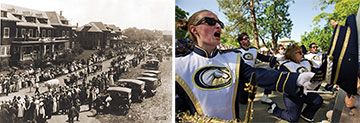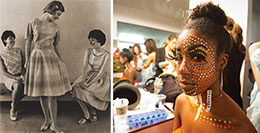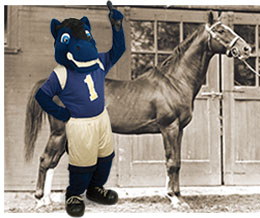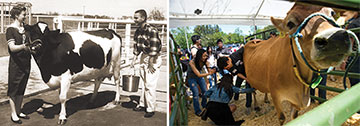Volume 31 · Number 2 · Spring 2014
100 Picnic Days
This spring, one of UC Davis’ longest-running traditions marks its centuple event. Will you be there?
Pack your picnic basket — or come without sandwiches. That quintessential UC Davis celebration, Picnic Day, reaches a historic milestone on April 12 — its 100th. But packing your own lunch is still optional, just like it was for the previous 99 Picnic Days.
What’s with the name?

1916 and 2013
From its very beginning, Picnic Day was never so much about the picnic as it was about the day of showing off the campus. Sure, the very first event held at the University Farm in May 1909 was a “basket picnic” affair, as in bring your own food. The campus didn’t have a dining commons, a Coffee House or much else in the way of dining facilities back then, though the university did pour free coffee and cream that day for visitors who brought their own cups and spoons.
The star of the show back then — as it always would continue to be over the next century-plus — was this marvelous experiment in higher education, a new-fangled farm school that would grow into this world-leading research university you know as UC Davis. By 1916, the open house was known as Picnic Day.
Hot dogs
The ever-popular Doxie Derby started in 1972 on Shields Avenue near the Quad, and moved a decade later to the Rec Hall, now called the Pavilion at the ARC (Activities and Recreation Center). The sheepdog trials have been a regular event since at least the 1940s.
The first open house
The raison d’ être for the first Picnic Day was the dedication of the campus’ first dormitory, North Hall. More than 2,000 people from around the state turned out. That may seem small compared to crowds in recent years of up to 100,000. But consider this: Enrollment in the Farm School at that time totaled just 18 students.

1964 and 2013
Students at the helm
While university administrators organized the first few events, students have been running the show since 1912. Picnic Day has long been billed as the largest student-run event in the nation, and we haven’t heard of any challenges to that claim.
The parade
The parade dates to at least 1912, when the main entries were prize livestock. Later years featured elaborate floral floats.
In 1987, the first-place float ended up in flames. In 2007, a KDVS entry, constructed with a small helium-filled blimp, floated away.
Doing the math
Yes, this year marks the 100th Picnic Day, but Picnic Day is more than a century old. The annual event skipped a few years along the way: in 1924, to prevent the spread of a hoof-and-mouth outbreak that led to the slaughter of nearly 110,000 farm animals throughout California; in 1938, due to rain-delayed construction of a gymnasium needed to house some of the festivities; and during 1943–45 when the campus closed for World War II. (The 1946 event wasn’t called Picnic Day but Round-up Day.)
Famous guests

Other 100s
The original Gunrock, namesake of the Aggie’s mascot, was born 100 years ago in Britain.
The pedigree Thoroughbred, after a brief racing career, became a UC Davis icon during his 1921–31 stay on campus as a breeding stud. Gunrock was part of a U.S. Cavalry program aimed at improving military and civilian horse stocks. Students later named the Aggie’s blue mustang mascot Gunrock in his honor.
The University Farm Circle, a women’s organization that has been providing financial support to students since UC Davis’ earliest days, marked its centennial in February.
Richard Nixon, then a congressman, was listed on the program as an honored guest in 1952. In July of that year, he would be selected as Dwight Eisenhower’s running mate; he was elected vice president the following November.
Retired Admiral Chester Nimitz, who commanded the U.S. Navy's Pacific Fleet during World War II, was on the guest list in 1953.
Earl Warren attended at least twice — once in 1953 in his final year as governor of California, and again in 1970, a year after his retirement from the U.S. Supreme Court, when he was the parade marshal. Warren was the parent of two Aggies — Earl Jr. ’52, a retired Sacramento County Superior Court Judge, and Bob ’58, a retired Davis real estate broker.
Gov. Edmund G. “Pat” Brown was grand marshal in 1962. Other state elected leaders have appeared at Picnic Days over the years. California’s 23rd governor, Hiram Johnson, was a speaker in 1916, just months before he won election to the U.S. Senate.
Rockin’ and rollin’
Strawberry Alarm Clock and the Youngbloods performed at Picnic Day in 1969. Quicksilver Messenger and Elvin Bishop played in 1970. Taj Mahal appeared in 1971.
Battle of the Bands
Legend has it that the Battle of the Bands began in the early 1970s, when the Cal Aggie Marching Band-uh discovered the Cal Band playing on the Quad after the parade and started blasting tunes back at the Bears in an effort to defend its turf. Over the years, the last-band-standing contest has pitted the Aggie Band-uh against rival bands from Stanford University, UC San Diego, UC Irvine, Humboldt State University and Oregon State University. The Band-uh claims to never have lost, perhaps due to a rule dating to at least the 1980s requiring the finale to be the Aggie fight song. The 2004 battle may have set a record, ending at 2 a.m.

1950s and 2013
Moving, and mooing, promotions
Learn more
about Picnic Day history
Picnic Day: A Century of Celebration will be on display at Shields Library from March 31 through June 5, and featured during the library's open house from 11 a.m. to 1 p.m. on Picnic Day.
For more information about the exhibit contact Special Collections Department Head Daryl Morrison or Collections Manager Sara Gunasekara at speccoll@lib.ucdavis.edu or 530-752-1621.
In recent years, students have challenged administrators and state lawmakers to a cow-milking contest on the Quad or the front steps of the state Capitol as a way of promoting Picnic Day. In older times, students — and cows — went to greater lengths to publicize the event.
In 1920, student W.P. Wing escorted Molly the cow on a bovine “race” from Davis to Berkeley. It took five days for the “galloping Galloway,” as the San Francisco Chronicle called Molly, to walk the 136-mile route by way of Sacramento and Stockton. The feat raised some protests from folks concerned about Molly’s welfare, but her caretakers insisted that she was no worse for the wear. Later photos of her showed her looking, well, beefy — and healthy enough to bear calves. Her son, Pete, would retrace her journey in 1921.
In 1917, student A.R. Kramer made a 1,000-mile trip by bicycle “to spread Picnic Day publicity material” from Davis to his home in the Imperial Valley.
In 1923, two students, Richard Barlow and Dave McMillan, handcuffed themselves back-to-back and set out on a 72-mile trek to Berkeley. A “Remember When” photo published in the Sacramento Bee in 1976 shows the pair near South Hall as they left campus. But no photo so far has surfaced to show whether they made it to their destination.
In 1951, students pushed wheelbarrows to Berkeley.
In 1972, the Picnic Day committee got some celebrity help in promoting that year’s “Remember the First Time” theme. Says Dennis Packer ’72, who was committee chair: “We got Gary Withem, the keyboardist and songwriter for Gary Puckett and the Union Gap, to volunteer and compose and sing a ditty that we used for radio commercials that went something like, “Remember the first time, remember the first, remember the first time.”
Find the full schedule of Picnic Day events.
